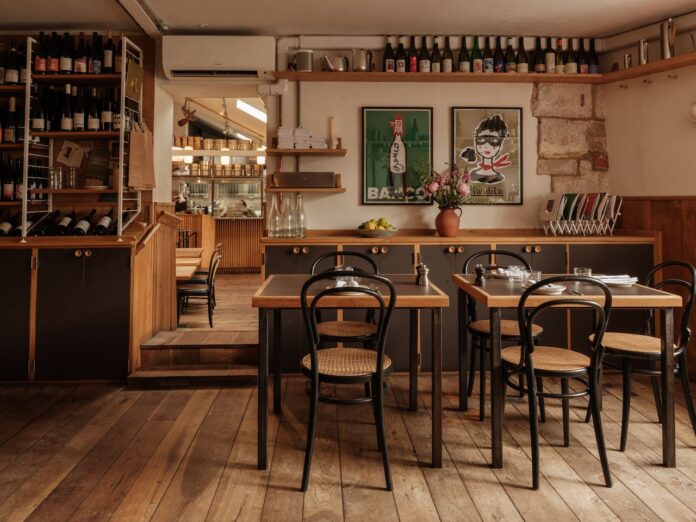In today’s competitive food industry, search engine optimization (SEO) is essential for restaurants looking to attract local customers. Whether you’re after increased foot traffic or online orders, your visibility on Google is essential in increasing custom. Here’s how to improve yours.
Focus On Local SEO
82% of smartphone users use search engines to find local businesses, according to Uberall.
For UK restaurants, local SEO is crucial because 46% of all Google searches are looking for local information, and 88% of consumers who search for a local business on a mobile device visit or call within 24 hours, according to HubSpot.
Practical Tip: Claim & Optimise Your Google My Business (GMB) Listing
Ensure your GMB profile is complete, with up-to-date information, business hours, and photos of your restaurant. Use relevant keywords in your GMB description such as “best fry up in London” or “authentic Bangladeshi restaurant in Manchester.”

Mobile Optimisation
A one-second delay in page load time can reduce mobile conversions by 20%, according to Think With Google.
With over 89% of all restaurant searches now happening on mobile, ensuring your website is mobile-friendly is essential. If your site doesn’t load fast or isn’t easy to navigate on smartphones, potential customers will quickly leave.
Practical Tip: Use Google’s Lighthouse Tool To Test Your Page
This tool can check if your site is optimised for mobile use. Make sure your menu, booking options, and contact details are easy to find and accessible from any device.
Optimise For Voice Search
According to BrainZ Digital, “By 2024, 75% of UK households are expected to own smart speakers like Amazon’s Alexa or Google Home. Optimizing for voice search is a forward-looking strategy for UK food shops.”
Voice search is rapidly growing, especially for local queries. 55% of teenagers and 41% of adults use voice search daily, and a large portion of these searches are for local businesses like restaurants, as Synup reports.
Practical Tip: Use Conversational Keywords
Voice searches often involve more natural language, so incorporate phrases that sound conversational. For example, instead of just “pizza restaurant Bristol,” use “Where can I find the best pizza restaurant in Bristol?”
Read: 7 steps to perform voice search optimisation for your content

Leverage Online Reviews
50% trust reviews as much as personal recommendations, as BrightLocal reports.
Online reviews are a powerful ranking factor for local SEO. Restaurants with high ratings and consistent reviews tend to appear higher in search results. According to BrightLocal, 87% of consumers read online reviews for local businesses.
Practical Tip: Encourage Customers To Leave Reviews
Offer a small incentive, such as a discount on their next meal, for leaving a review on Google or TripAdvisor. Also, always respond to reviews, both positive and negative, to show you care about customer feedback.
Create High-Quality Content
Content marketing generates 3x more leads than traditional marketing methods, and restaurants that blog regularly see an increase in traffic and bookings, according to Review 42.
Content marketing helps you target specific keywords and provide value to potential customers. However, this doesn’t just mean writing blogs; it can include videos, recipes, or even guides to local food events.
Practical Tip: Create ‘Ultimate Guides’
Ultimate guides can generate prestige, authority and traffic. For example, “The Ultimate Guide to Vegetarian Food in Bath” could attract local vegans searching for restaurant recommendations. Use local keywords and optimise your posts with helpful headings, lists, and images.
Read: Where to eat the best vegetarian food in Bath
Optimise For “Near Me” Searches
Google searches for “near me” have grown by 500% in the last few years.
Many users search for restaurants using phrases like “near me,” especially from mobile devices. In fact, 76% of people who conduct a local mobile search visit a related business within 24 hours, with 28% of those visits resulting in a purchase.
Practical Tip: Include “Near Me” Keywords in Your Content
Sprinkle location-specific keywords across your website. Phrases like “best fish and chips near me” or “coffee shop near me in Leeds” should be naturally integrated into your content, headings, and meta descriptions. That word ‘naturally’ is absolutely essential here, mind.

Utilise Social Media For SEO
Instagram has over 2 billion users, and food-related posts make up a large chunk of its content, according to Omnicore.
Social media can indirectly improve SEO by driving traffic to your site and boosting engagement. More than 75% of consumers have intended to make a purchase based on a social media post.
Practical Tip: Post Regularly on Instagram and Facebook
Share high-quality images of your dishes, promote special offers, and use geo-tags and hashtags like #LondonEats or #ManchesterFoodie to increase visibility.
Optimise Your Menu For SEO
Websites using structured data see a 30% increase in click-through rates (CTR), according to Search Engine Land.
Menu optimisation is often overlooked, but search engines can’t read images of your menu. Ensure your menu is text-based, and use relevant keywords for the dishes you serve.
Practical Tip: Use Structured Data for Menus
Implement schema markup (structured data) on your menu to help search engines understand your offerings better. This can result in rich snippets in search results, showcasing your menu items, prices, and reviews.
Build Local Citations
Research by Bright Local suggests that 93% of consumers are frustrated by incorrect information on online directories, and 80% say they will lose trust due to inconsistent contact details.
Local citations are mentions of your restaurant’s name, address, and phone number (NAP) on other websites, such as local directories or review sites. Consistent citations boost your local SEO rankings.
Practical Tip: List Your Restaurant in Online Directories
Ensure your NAP is consistent across platforms like Yelp, TripAdvisor, OpenTable, and local UK food blogs.
And with that, let’s instead read about the interesting part of restaurants – the food! Check out our guide to the best value set lunches in Mayfair for some light relief from the above.





